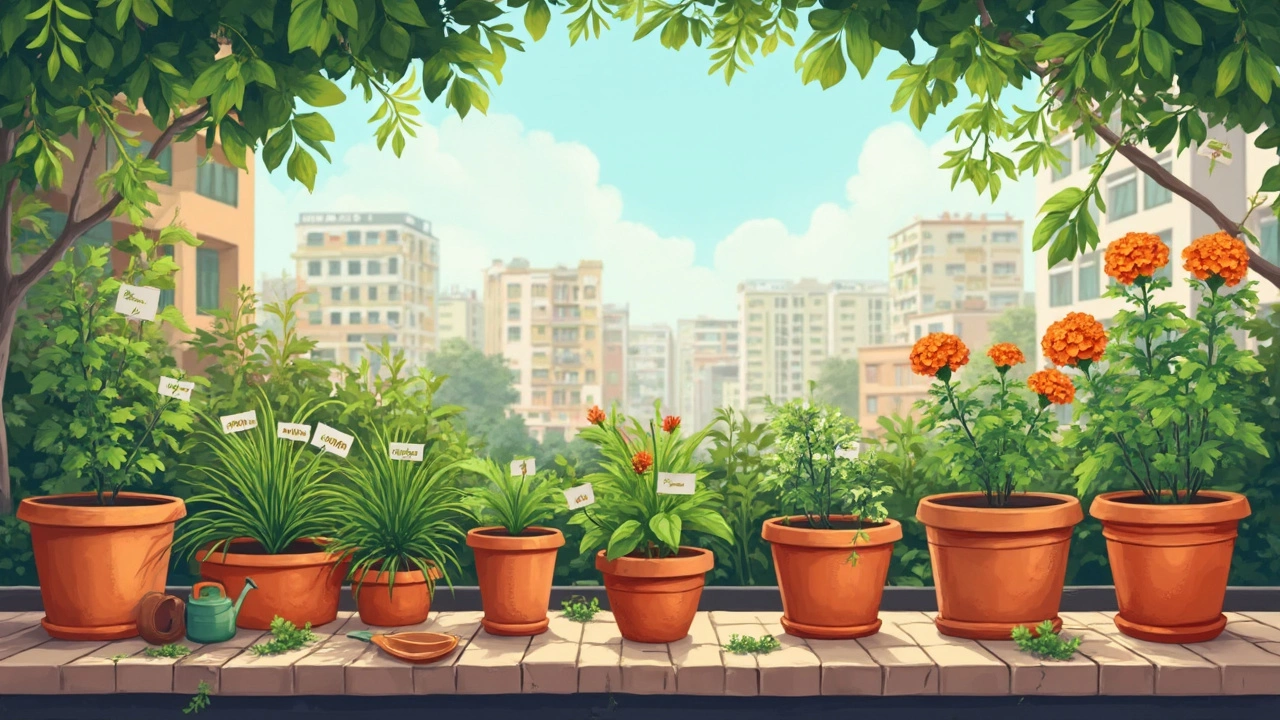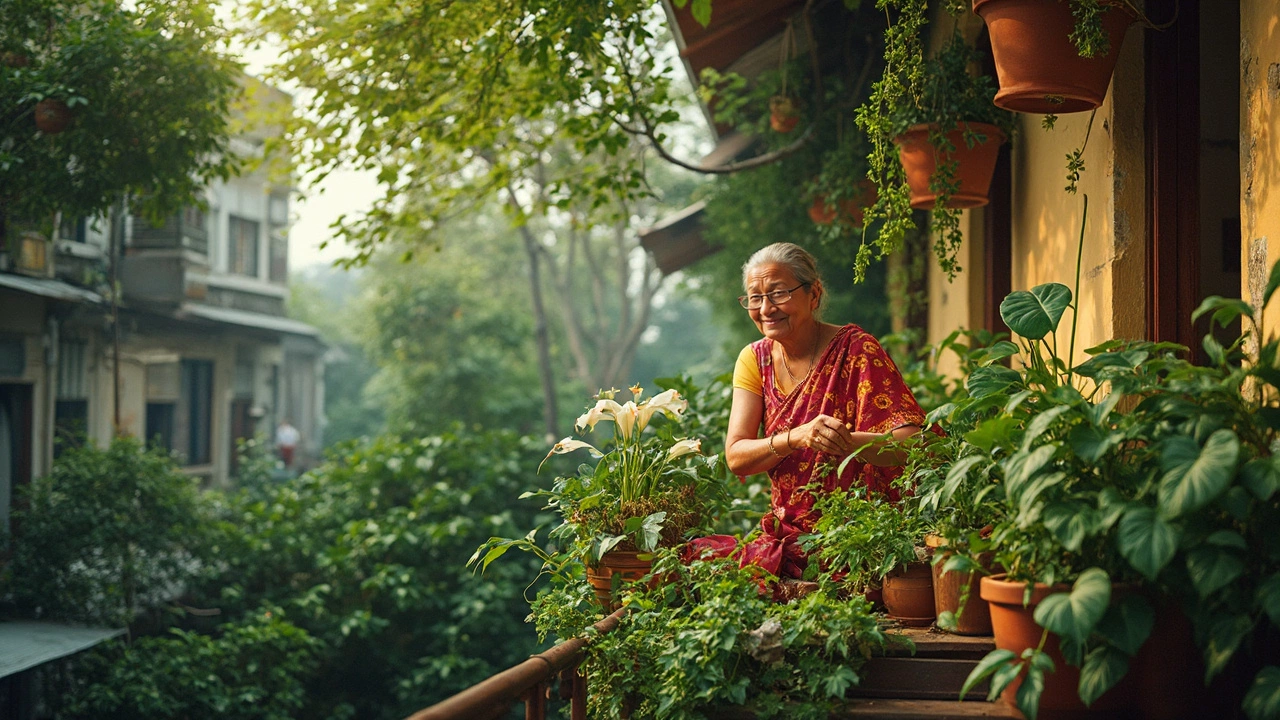If your balcony barely gets any sun, you might think there’s no hope for a garden out there. The good news? Loads of plants actually prefer shade, and some even look better because of it. Before you go plant shopping, spend a day or two just watching your space—see when it gets light, for how long, and if anything blocks it (like buildings or large trees). No direct sun at all? That’s full shade. A few hours, especially in the morning? That’s partial shade. This makes a big difference in what thrives.
A common mistake is treating all shade the same, but a balcony under a fire escape isn’t like one facing north with filtered light. Once you know your type, picking the right plants gets way easier. Think ferns, hostas, and begonias—they’re classics for a reason. If you like herbs, mint and chives don’t complain about low light. Want to impress? Try caladiums for wild leaf colors or fuchsia for droopy, standout flowers—even in heavy shade, they put on a show. I’ll get into more details and easy tips on choosing, potting, and keeping them alive, even if you’re new to this whole gardening thing.
- Understanding Your Balcony’s Shade
- Top Plants That Love the Shade
- Setting Up for Success: Pots, Soil, and Watering
- Smart Maintenance for Happy Shade Plants
Understanding Your Balcony’s Shade
If you want a successful shade plants setup, you need to know exactly what type of shade your balcony has. Shade isn’t just one thing—it actually ranges from light to deep, and it really matters when picking plants. Start by checking where your balcony faces. North-facing spaces usually get the least direct sunlight, while east-facing ones may catch some gentle morning rays. Southwest balconies can get hot, even if it feels shady, because afternoon sun bounces around.
Next, estimate how much light really hits your balcony. Use your phone’s clock and snap pics every few hours. If there’s under two hours of sunlight daily, it’s full shade. Two to four hours, especially in the morning, is part shade. More than that and you’re not as limited. Another trick: look at the shadows. Crisp, sharp shadows mean stronger sunlight. Blurred or no shadows mean pretty deep shade.
Don’t forget about obstacles—overhangs, nearby buildings, big trees, or even balcony railings can block light, especially as seasons and sun angles change. If there are lots of reflective surfaces like light walls or glass panels nearby, you might get more “indirect” light than you realize, which helps certain plants. Balconies high up might get more wind, which can dry out soil faster, even in the shade.
Bottom line: Measure your light and notice changes through the seasons. That way, you won’t waste money on the wrong plants or end up babysitting something that just won’t last. Getting the shade question right makes the rest of your balcony garden setup way easier and way more satisfying.
Top Plants That Love the Shade
If you’re hunting for balcony plants that won’t sulk without the sun, there are plenty of great picks. The trick is choosing shade-tolerant varieties—not just any houseplant will do. Some need full shade, while others can handle a little indirect light. Here are some standouts that actually look lusher in lower light:
- Ferns: Boston ferns, maidenhair, and bird’s nest ferns love shade and bring a cool, tropical vibe. They need regular water and humidity but repay you with feathery foliage.
- Hostas: Easy to grow in pots, hostas come in a ton of leaf shapes and colors. Most varieties don’t mind shade and can even take direct sun for an hour or so, but prefer to stay out of harsh midday rays.
- Begonias: Wax and tuberous begonias put out blooms even in the shadiest spots. They’re pretty low-maintenance and happy in containers.
- Caladiums: These are show-stoppers if you want wild, colorful leaves. Shade actually makes their colors pop more, and they won’t get scorched like in direct sun.
- Heuchera: Also called coral bells, these come in funky leaf colors from deep purple to lime green and pink. They tolerate shade, handle cramped planters, and can survive chilly weather.
- Impatiens: If you want constant flowers, impatiens will bloom non-stop in shade, making them a balcony classic.
Herbs can work too, even if you’re not growing for big harvests. Mint, parsley, chives, and even cilantro do fine in low light. Mint’s almost impossible to kill, but keep it in its own pot—this stuff spreads like crazy!
If you want bigger texture and a splash of drama, try a Japanese forest grass (Hakonechloa)—it looks fancy, but it’s super tough and shade-loving. For something trailing, English ivy or golden pothos spill nicely from hanging baskets and don’t need much sun. Remember, if you’re in a high-rise or windy spot, pick heavier pots or weighted planters, so nothing tips over.
Curious how these favorites stack up? Here’s a quick cheat sheet for the most popular balcony-friendly shade plants:
| Plant | Best Light | Water Needs | Size in a Pot |
|---|---|---|---|
| Boston Fern | Full-Partial Shade | High | 30-60cm tall |
| Hosta | Full-Partial Shade | Medium | 20-40cm tall |
| Begonia | Partial Shade | Medium | 15-30cm tall |
| Caladium | Full-Partial Shade | Medium-High | 30-45cm tall |
| Impatiens | Full-Partial Shade | High | 20-30cm tall |
| Mint | Partial Shade | Medium | 20-25cm tall |
Don’t feel limited—a surprising number of low-light options do well outside on a balcony garden, especially if you give them good soil, regular water, and a quick check for pests every week or two.

Setting Up for Success: Pots, Soil, and Watering
Your plant setup on a shady balcony is way more than just cute pots. Get these basics right and your shade plants will thank you.
First up, pots. Drainage matters most—skip pots without holes. Water stuck at the bottom is a sure way to rot roots, especially in low light since the soil stays wet longer. Go for plastic or fiberglass if lightweight matters, or clay if you want things to dry out a bit faster. If you go big, try a self-watering pot (just don’t overdo it—full shade really slows water use).
Now about soil. You want a quality potting mix, not the stuff straight from your yard. Most regular potting soils at a garden store work fine, but double-check the label for good drainage and a little bit of compost or slow-release fertilizer. Steer clear of "moisture control" mixes—they tend to keep things too soggy for shade plants.
For watering: less is more. Shade means pots dry out slower, so don’t fall for the myth that more water is always better. A good rule? Stick your finger two inches in the soil. If it feels dry, water. If not, wait. Overwatering is where most folks mess up.
| Potting Decision | Best Choice | Why? |
|---|---|---|
| Pots | Pots with drainage holes | Avoids root rot, key for shade |
| Soil | Light, well-draining potting mix | Prevents sogginess in low light |
| Watering | Only when soil is dry to the touch | Stops overwatering problems |
Here’s a simple checklist for balcony pots:
- Pick pots with drainage holes—don’t risk it, even if you love the look of a fancy pot. Use a cheap nursery pot inside if you must.
- Use good potting soil; upgrade with some perlite for even better drainage if your shade is deep and cool.
- Watch your watering (stick to the finger test, not a schedule).
- Put saucers under pots to avoid balcony mess, but don’t let water sit in them for more than an hour.
So setting up for shade success comes down to smart pots, lighter soil, and a careful watering hand. Get that trio right, and you’re golden—even for the trickiest balcony spot.
Smart Maintenance for Happy Shade Plants
Just because your plants live in the shade doesn’t mean you can ignore them. Shady spots on balconies tend to be cooler and hold moisture longer, so you’ll need to change your care routine a bit compared to what’s typical for sunny gardens. Overwatering is the biggest mess-up. It’s way too easy to drown your plants when the soil doesn’t dry out fast, especially for those new to the shade plants game.
Get in the habit of checking the soil before you water. Stick your finger about an inch down. If it’s wet, wait a bit. Shade-loving plants like ferns and hostas enjoy steady moisture, but soggy soil can cause root rot, especially in closed pots. Also, use pots with drainage holes—never skip this. Seriously, root rot can take down even the toughest plant faster than bugs or cold weather.
Fertilizing is another area where less is more. Most shade plants don’t need a ton of food. Too much fertilizer leads to soft, leggy growth that doesn’t look great. Try feeding every six to eight weeks with a diluted, all-purpose liquid fertilizer during the growing season (usually spring and summer). Take a break in fall and winter; your plants don’t do much growing while it’s cold.
- Trim yellow or rotted leaves regularly. This keeps everything tidy and helps new growth.
- Watch for bugs like spider mites or aphids. Flat shade and crowded balconies can still host pests, especially if air isn’t moving.
- If your space gets a breeze, rotate pots every couple weeks, so leaves don’t lean too much in one direction.
- Avoid packing pots too tight. Airflow helps prevent mildew and leaf spot problems, which are more common in the shade.
Finally, clean your balcony often. Dust, fallen leaves, and pooled water make problems for both your plants and the structure. Keeping things tidy not only helps your plants stay healthy but also makes your garden a nicer place to hang out. With a bit of regular attention, even shade gardens on balconies can stay lush and vibrant year-round.

